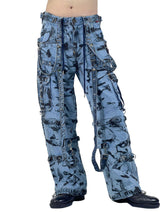History & Evolution of Gothic Fashion
Stepping into the cobbled alleys, a whisper brushes past, carried on the echoes of leather boots and silver chimes. A figure emerges from the fog, draped in black velvet, eyes painted with kohl, a testament to a style that dances with darkness and defies convention. This is the world of goth fashion, a mesmerizing tapestry woven from rebellion, artistry, and an undying love for the shadows. Today, we embark on a thrilling journey through its captivating history and electrifying evolution.
From Punk’s Ashes to Gothic Dawn (1970s-80s):
The embers of punk’s rebellion gave rise to a defiant style. Siouxsie Sioux and The Banshees, draped in ripped fishnets and torn clothing, wielded their dark makeup and spiky hair like battle cries against conformity. This raw angst birthed post-punk, the fertile ground where the seeds of goth would take root.
But the darkness blossomed with an unexpected elegance. Victorian echoes whispered in the form of corsets and lace, the influence of the Gothic Revival infusing the style with romantic melancholia. Bands like The Cure painted sonic landscapes of introspective darkness, while The Mission donned velvet capes and brocade waistcoats, creating the aristocratic grandeur of traditional goth.
Beyond Black: A Tapestry of Subgenres (1990s-Present):
The 1990s witnessed a kaleidoscope of subgenres, each a brushstroke on the canvas of defiance. Deathrock, spearheaded by Bauhaus and Christian Death, embraced the macabre, wielding face paint and tattered fishnets like war paint. Meanwhile, cybergoth rewired the genre, infusing industrial music’s metallic pulse with neon accents and PVC, a rebellion against societal norms through technological augmentation.
Ethereal whispers rose from the depths, courtesy of ethereal goth. Cocteau Twins and Dead Can Dance wove dreamscapes of pastel hues and delicate fabrics, offering a softer embrace of the shadows. But the spectrum deepened further. Aristocrat goth, with its velvet capes and decadent jewelry, channeled aristocratic hauteur, while Gothic Lolita combined childlike innocence with dark undertones, a playful defiance against social expectations.
Adapting to the New Millennium:
Today, goth fashion isn’t confined to a museum exhibit; it’s a living, breathing entity. Social media has democratized the style, with platforms like Instagram bursting with diverse interpretations. Vintage finds blend with DIY creations, streetwear collides with historical references, and every outfit becomes a canvas for self-expression. Performative aspects thrive, from intricate gothic cosplay to the theatrical allure of goth cabaret.
The Shadows Beckon: What Lies Ahead?
What future awaits this ever-evolving style? Perhaps technology will weave its magic, with bioluminescent clothing or interactive elements. Maybe sustainability will take centre stage, with upcycled materials and ethical practices leading the charge. One thing is certain: the shadows will continue to inspire. Goth fashion remains a vibrant tapestry woven from rebellion, self-expression, and a shared love for the beauty found in the darkness.
Conclusion:
So, dear reader, step into the shadows. Embrace the darkness. Let your dark light shine, and remember: goth fashion is more than just clothing; it’s a community, a philosophy, a way of life. It’s a love letter to the night, a whispered rebellion against the mundane, and an invitation to paint your own masterpiece on the canvas of your soul.
Now, the journey continues… share your thoughts, delve deeper into your favourite subgenres, and let the conversation about the future of goth fashion take flight in the comments below!








